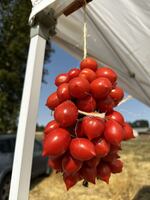As growing seasons become hotter and drier across the region, farmers are increasingly challenged to grow and sustain their crops.
Now Oregon State University is close to launching a dry farming map project.
Lucas Nebert, a research associate at OSU, heads the project. He told KLCC that a lot of farmers are interested in alternatives to growing crops that are reliant on irrigation.
“We see that with drought, more and more people are getting their irrigation shut off or wells running out of water,” Nebert explained. “And dry farming is seen as a water resilient strategy in that you don’t need to irrigate throughout the season.”
The Dry Farming Institute defines dry farming as a “low-input, place-based approach to producing crops within the constraints of your climate.” A dry-farmed crop, according to the institute, is irrigated “once or not at all.”

Matt Davis, an OSU research assistant, slices up dry-farmed melons at a recent event at the Oak Creek Center for Urban Horticulture.
Brian Bull/KLCC
To address farmers’ curiosity as to whether or not they can dry farm in their region, Nebert said OSU’s team had soil scientists come out and assess site suitability.
“This map might be more proactive approach where growers can log on and see the potential suitability in their area.”
The maps will show areas suitable for dry farming, as well as places where the soil has adequate water retention, or is relatively frost-free.
Melons and tomatoes on the taste test
At the Oak Creek Center of Urban Horticulture in Corvallis recently, about 60 people attended a presentation on strategies for farming with less irrigation. Under a tent, OSU research assistant Matt Davis sliced melons, as Desiree Braziel sampled them.
“So the Piel de Sapos are Spanish melons, they have really low aromatics,” explained Davis. “But they’re really sweet.”
“Mmmm, soooo sweet and delicious,” agreed Braziel.

A bunch of tomatoes that are dry-farmed hang on display at a recent OSU event. These types are common in Spain and Italy.
Brian Bull/KLCC
Braziel designed the suitability maps for OSU’s dry farm mapping project. This was her first time sampling produce raised in arid conditions.
“I’ve been working on this project for six months, it’s great to taste the fruits of the labor,” she said.
A variety of melons and tomatoes were shared with the crowd, as a way to demonstrate what’s possible on a dry farm. Advocates say this type of farming can yield flavorful yet sustainable produce.
Braziel said her maps will give Oregon growers an idea of where dry farming can happen.
“So that people can continue to cultivate delicious crops, and I think with them being able to be stored longer like food will be more abundant in that regard.”
OSU’s dry mapping project will be published online sometime in September.
Dry farming is not a new innovation, but one that goes back to the earliest days of agriculture. Native Americans and other Indigenous people have practiced it with a number of fruits, vegetables, and grains.